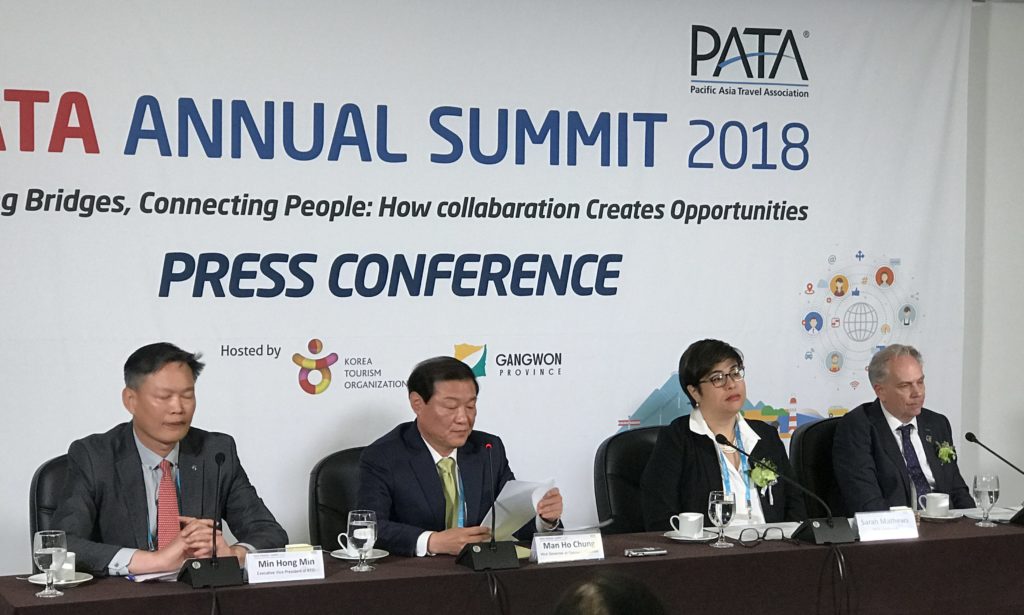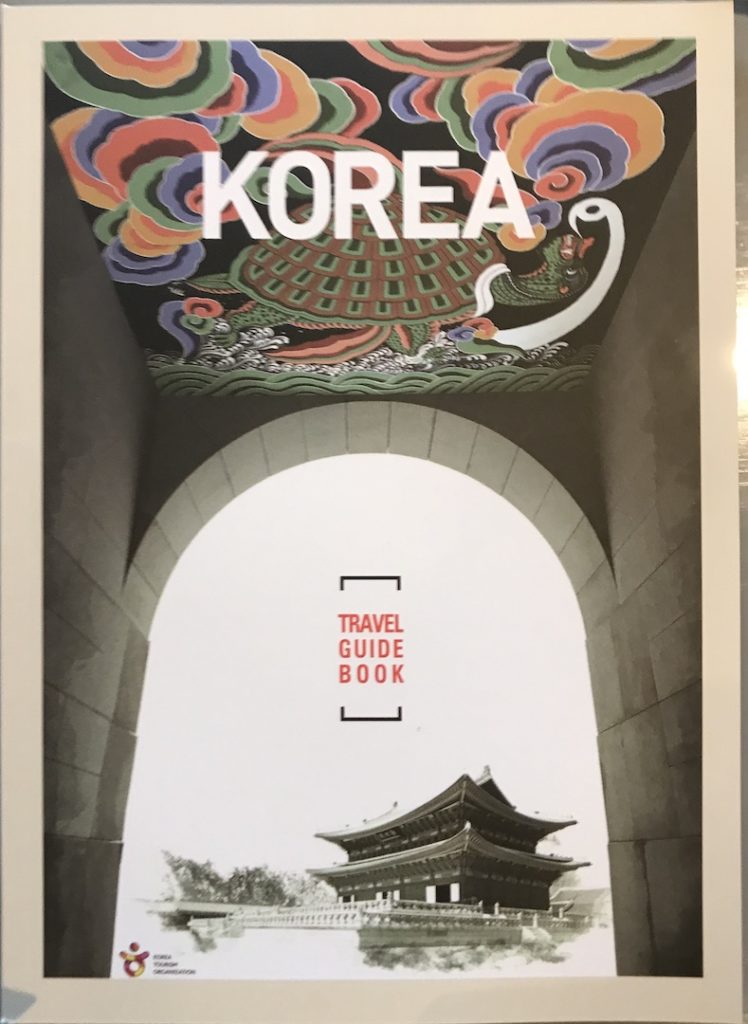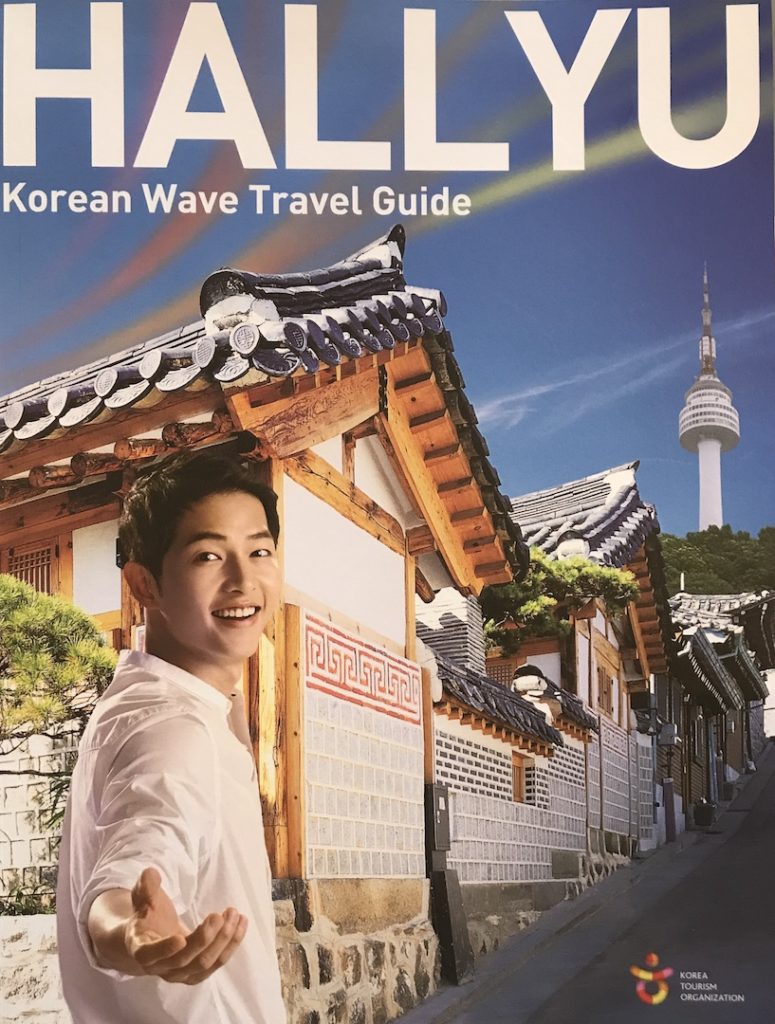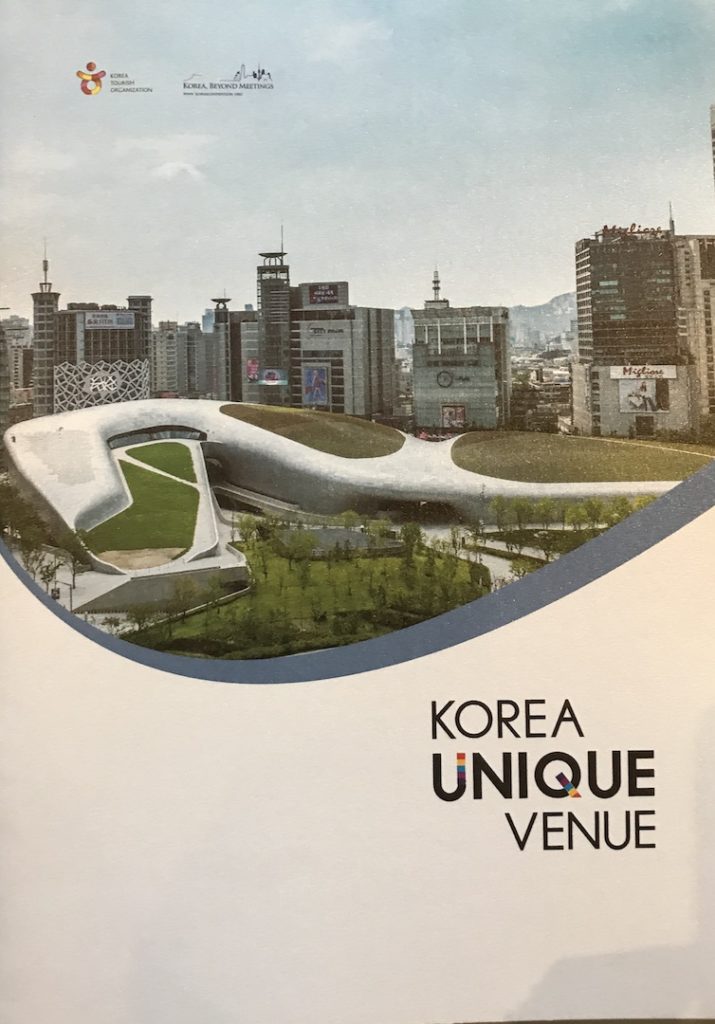
23 May, 2018
Korea’s new, improved tourism marketing & development strategy to counter arrivals decline
Gangneung, Gangwon Province, South Korea – From developing its Muslim-friendly facilities to promoting travel by physically-challenged people and supporting SMEs, Korea has embarked upon a detailed marketing and development strategy to counter a sharp decline in visitor arrivals in 2017.
Details of the plan were outlined to media covering the PATA Annual Summit 2018 by Mr Min Min Hong, Executive VP for International Tourism, Korean Tourism Organization. This editor asked Mr Min for the full text of his presentation, which he was happy to supply. Reproduced here in full, it provides a valuable update for everyone selling Korea as a destination as well as for less-developed countries seeking to craft their own tourism strategies.


At the Press conference, from left, Mr Min, Gangwon Province Vice Governor Mr. Man Ho Chung, Immediate past chairman PATA Sarah Matthews, PATA CEO Mario Hardy.
1. Qualitative Growth of the Inbound Tourism Market
□ Pursue balanced growth through strategic diversification of the inbound market
○ “Boom-up” marketing to move up into a major market again
– (China) Hold the Trilateral Ministerial Meeting on Tourism early (3Q) as well as present Korean tours to Chinese travel agencies; run image advertisements to promote Korea tourism across China (3Q); and attract Chinese tourists with quality tour products (30,000 people).
– (Japan) Conduct a “Korea tourism boom-up” campaign in partnership with major local travel agencies (30,000 people); produce and run Korean versions of popular Japanese TV programs including Lonely Gourmet (May-July); and hold a Korea tourism festival (June, Tokyo).
○ Focus on developing new markets and enhance the awareness of Korea as a tourist destination in emerging markets
– (New markets) Create new demand from second-tier cities
* [Taiwan] Held or will hold events in the mid-southern region including the Korea Tourism Festival in Kaohsiung (April), an EXPO in Taichung (May), the Korea Travel Fair in Kaohsiung (September); and jointly promote Korea with airlines who have launched new routes to second-tier cities (Jeju Air, etc.)
* [Vietnam, Indonesia] Hold one or more presentations for local travel agencies in second-tier cities (Vietnam – Ho Chi Minh, Hai Phong, Danang, Can Tho, and Thanh Hóa. Indonesia – Surabaya, Medan, and Bandung); provide two or more FAM tours in Korea; and jointly develop tour products with local travel agencies
– (Emerging markets) Create demand for tours in Korea by establishing pro-Korea networks in India and Kazakhstan. Develop VIP-only tour products in collaboration with the largest bank in Mongolia (Golomt Bank).
○ Carry out high value-added marketing campaigns targeting active seniors
– (Active Seniors) Develop 30 customized tour products for seniors in collaboration with AARP (American Association of Retired Persons), the largest senior group in the U.S. Participate in specialized exhibitions for seniors and promote Korea as a tourist destination (Golden Future Expo, San Diego in September).
○ Create a Muslim-friendly tour environment
– Increase the number of Muslim-friendly restaurants in Korea from 238 to 250 and improve the quality of service
* Muslim-friendly restaurant categories: Restaurants are categorized into four categories depending on ingredients used and the level of Muslim-friendly service available to provide Muslims a convenient stay in Korea.
– Hold the “Halal Restaurant Week” (Aug.16-Oct.15), a promotional event, which will include 100 Muslim-friendly restaurants, 20 tour-related businesses, and 60 accommodation facilities with prayer-rooms.
– Install more prayer rooms mainly in major transportation facilities (airports, KTX stations, etc.) (Prayer rooms are currently available at 31 locations)
□ Facilitate visitor economy by reinforcing high-value added marketing
○ Host high value-added MICE events
– Hosted 20 large international conferences to attract 35,000 visitors (25.9% y-o-y increase)
– Attracted 285,000 people for business conferences and incentive tours through marketing in emerging and new markets (40.7% y-o-y increase)
○ Develop and promote Korea’s unique tour content
– (Luxury Tours) Develop high value-added tour content (100 items in the 1H) and hold a Korea Luxury Travel Mart (September).
– (Medical / Wellness Tours) Run more tours / activity programs for international patients and their families. Develop Korean-style wellness & tour content (from 25 items in 2017 to 30 items in 2018)
– (Themed Tours) Develop more K-pop concert-related tour products (8 events per year, to attract 100,000 visitors); select and promote 20 traditional markets; hold a performance tour festival in Daehangno (September-October); and establish KTO’s branch offices in strategic regions to facilitate Korean themed cruise tours.
○ Establish a quality certification system for tour-related businesses
– (Objective) Introduce a unified national tour service certification system (accommodations, shopping, etc.) and carry out quality control to enhance the tour industry’s competitiveness.
* Currently there are 89 different certification systems in Korea
– (Description) Introduce a unified quality certification system (Tourism Promotion Act revised on March 13, 2018); review and certify facilities (a total of 369 facilities including accommodations and shopping facilities are certified as of March); and manage certified facilities as well as support their promotion.
□ Facilitate regional tourism by encouraging foreign tourists to visit various regions in Korea
○ Select major tourist sites and tour products to develop them into “brands” and provide focused marketing
– Selected 10 regions in Korea to develop the “10 Themed Tours in Korea” and provided focused marketing
– Developed “glocal” tour products for tour courses in 10 regions that are attractive to foreign visitors; and attracted tourists in collaboration with local travel agencies
○ Develop specialized local tour products including post-PyeongChang products and carry out customized promotions
– (China) Developed “signature routes” for Chinese FITs (26,000 people).
– (Japan) Developed “Gangwon special” products whereby Japan’s speed skating & curling stars accompany tourist as well as tour products related to the “2nd Walking Festa in Baekje,” and “Busan Gijang King Crab Campaign” (16,000 people). Ran Korea kotochi (local) shuttle buses (5 routes).
– (Southeast Asia) Developed the 2018 April Snow for Thai tourists (600 people), four season tours of Gangwon-do for Indian tourists, and tours for Vietnamese and Philippine tourists in line with their temporary no-visa entry through Yangyang Airport (2,000 people)
– (Europe and Americas) Developed long-term ski & stay package products in line with four ski resorts where the PyeongChang 2018 was held, as well as post-PyeongChang products for tourists from 3 Northern European countries (Sweden, Finland and Norway).
2 Tourism That Everybody Can Enjoy
□ Facilitate tour activities for vulnerable social groups
○ Create “accessible tourist sites*” for the disabled to guarantee the public’s right to enjoy tours
– Hold a contest for “accessible” tourist sites (12 new accessible tourist sites in 2018); provide consulting as well as support renovation; and carry out promotional activities (currently 17 accessible tourist sites, create 100 by 2022).
* Tourist sites that every tourist (including the disabled and elderly) can conveniently enjoy without limitations
○ Provide tour opportunities for vulnerable social groups
– Developed tour routes for the disabled and created a separate section (on the Visit Korea website) to provide them with useful information.
– Supported activity-based tours for students of special-education schools and after-school programs (5,300 people from 102 schools)
□ Vitalize the public’s vacation culture by providing financial aid for workers’ vacations
○ Improve vacation culture by providing support to employees of small companies to travel in Korea
– Provide financial support for travel expenses — 100,000 won or 25% of 400,000 won / person to 20,000 employees
* Travel expense sharing: 50% by employee (200,000 won), 25% by the company (100,000 won), and 25% by the government (100,000 won)
* Workers participating in the program can use points that is worth 400,000 won for domestic travel products at a designated online shopping mall.
* Approximately 100,000 people from 8,561 companies applied for the program. Employees will be able to use the points from June 2018 to February 2019
3 Promote the Tourism Industry Using Advanced Technology
□ Support tour startups
○ (Nurture tour startups) Create a virtuous cycle of finding (holding a contest) and developing (supporting business set-up, providing consulting) tour-related startups as well as accelerating their growth (supporting growing business and identifying markets).
* Found 462 startups and created 1,406 jobs from 2011 to 2017
* Will choose 70 startups in 2018 (40 newly-opened tour startups and 30 existing tour startups)
○ (Reinforce tour startups’ capabilities) Provide specialized consulting services for tour startups and help them find markets for each growth phase.
– Provide customized support for both newly-created tour startups (companies less than 3 years old) as well as those older than 3 years based on their growth phase and give preference to youths living in provinces to create more job opportunities for youths.
– Created a tour startup incubating facility on the 7th and 8th floors of the KTO building to provide office space to 40 startups as well as support their businesses (business training, etc.)
□ Support Investment Needs of Small Tour Companies (crowdfunding)
○ Match startups and investors through crowdfunding and provide support of startup financing to reinforce the competitiveness of small tour companies
* A total of 121 companies applied for crowdfunding with 84 successfully receiving funding (16.29 million won, January 2017-March 2018)
– (Explore Companies) Find small tour companies who want to raise funds through crowdfunding: 100 companies
– (Provide customized consulting) Provide training, consulting and related fees support for funding success.
– (PR & Marketing) Vitalize crowdfunding and raise the awareness of tour-related companies
□ Open tour information for ICT converged tour services
○ Improved tourists’ convenience by establishing a Korea tour information database and providing Tour API.
– Made 660,000 informational materials public, such as 140,000 items related to tourist sites in 9 languages as well as 520,000 photos.
– Korean tour information was searched 27.72 million times per month (as of April 2018)
* Among the 2,525 services offered by 697 institutes on the public data portal run by the Ministry of Interior and Safety, KTO ranked 3rd in terms of search frequency.
– 487 app or web based services were created using open data
* Received the “Smart Public Organization Award” at the Fourth Industrial Revolution Management Awards (August 2017) and the Grand Prize at the Korea ICT Innovation Awards (April 2016)
○ Made 1.3 million POIs (Points of Interest) public in multiple languages and established individual tourism big data
* Established 1.3 million POIs (325,000 POIs per language x 4 languages) (data available through Tour API)
□ Run a customized portal (Visit Korea For Me) for FITs
○ A portal site providing information of recommended tour products (optional tours, activities, etc.) as well as tour routes for FITs
* Tour products are registered and promoted on the portal site, and visitors can click a link to visit the seller’s site and purchase products.
– (Foreign tourists) Can acquire and search individual tour information (products, services, and travel information)
* Related tour information is automatically pushed based on history of users’ page views.
* Customized information retrieval: Users can retrieve relevant information geared to their age, nationality and purpose of visit.
– (Korean tour industry) Register promotional information and introduce companies and their major services.
– (KTO/Public organizations) Register internally developed FIT products as well as quality Korean tour products.






Liked this article? Share it!